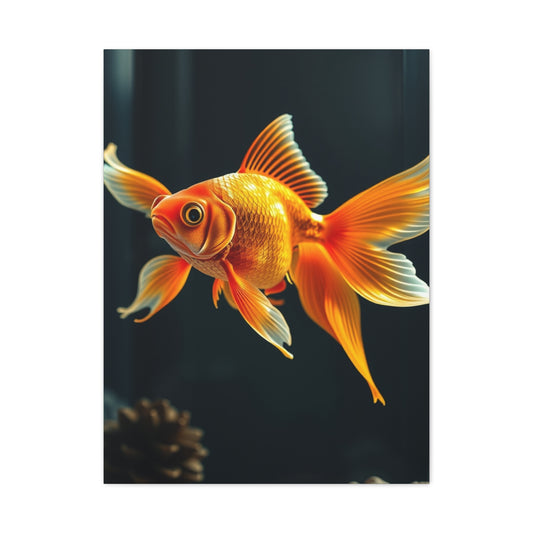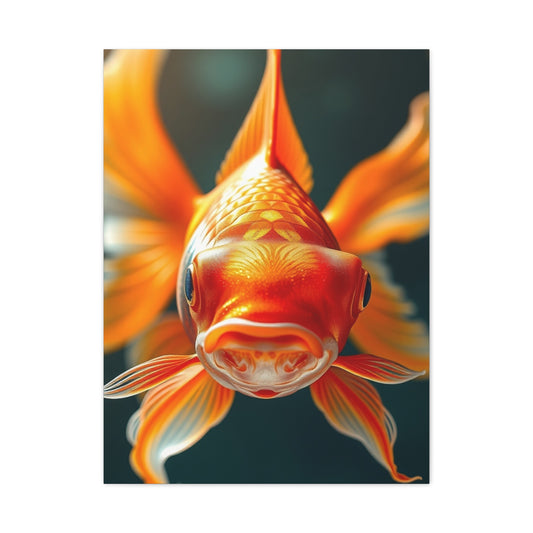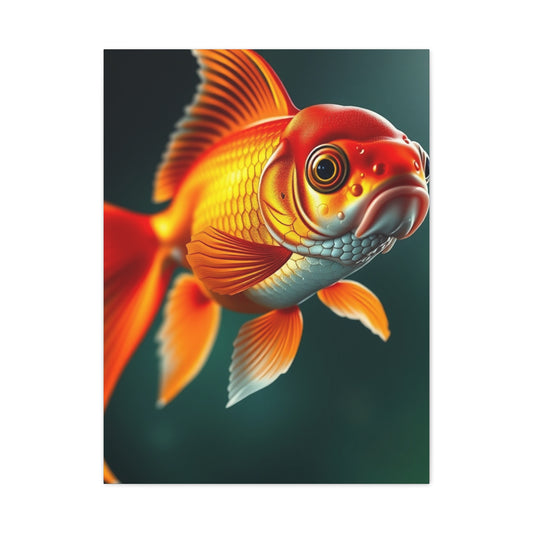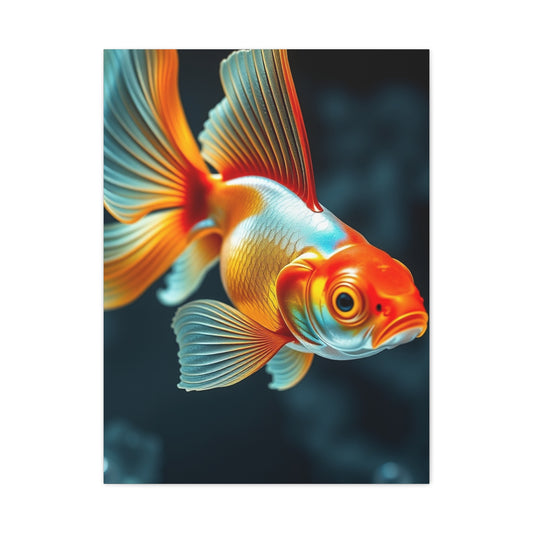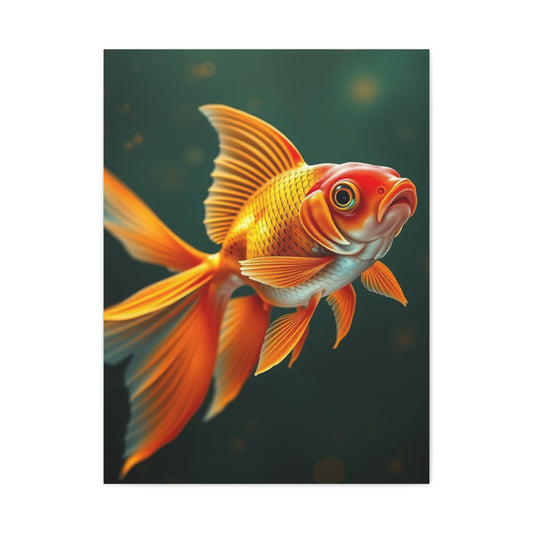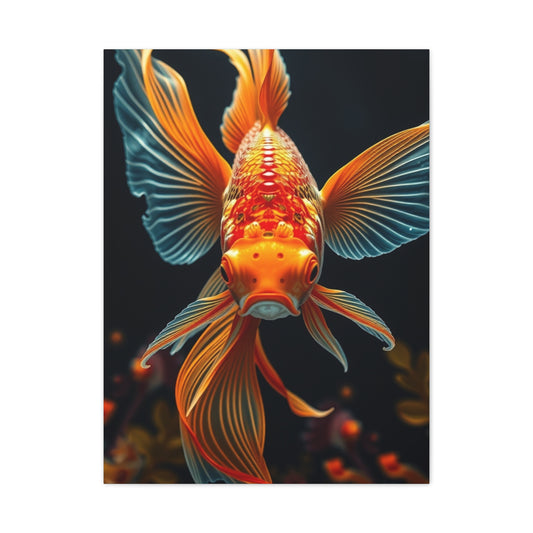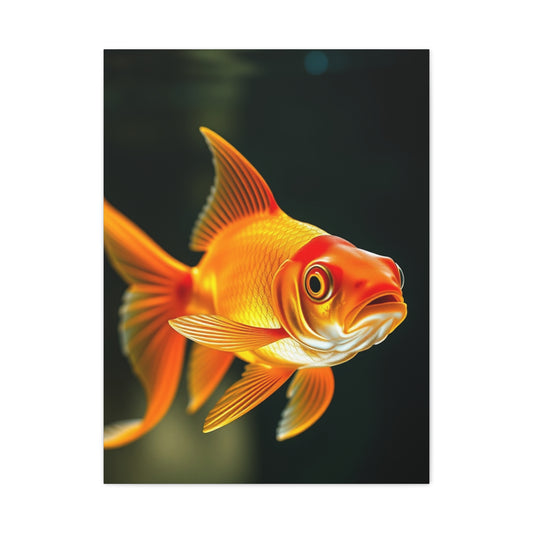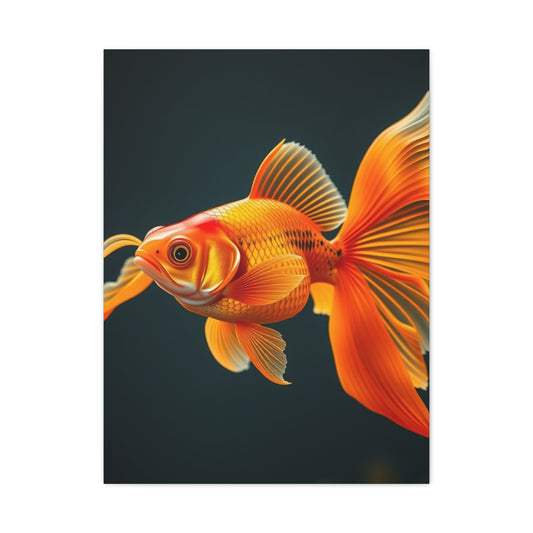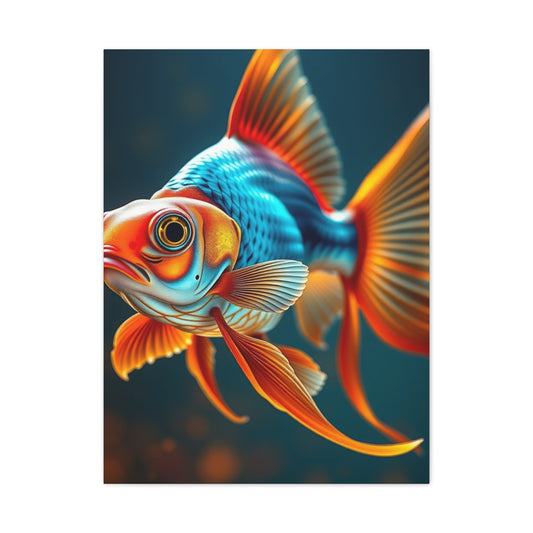DIY Goldfish Wall Art Projects for Personalized Décor
The realm of interior design has witnessed a remarkable surge in the popularity of aquatic-themed artwork, particularly goldfish wall art. This captivating form of visual expression brings the serene beauty of underwater life directly into our living spaces, creating an atmosphere of tranquility and wonder. Goldfish wall art encompasses a diverse spectrum of artistic interpretations, from realistic watercolor paintings that capture every delicate fin detail to abstract representations that evoke the fluid grace of these beloved aquatic creatures.
The allure of goldfish artwork extends far beyond mere decoration. These pieces serve as windows into an underwater paradise, transforming ordinary walls into portals of serenity. The gentle curves and flowing lines characteristic of goldfish imagery naturally complement various interior design styles, making them versatile additions to any home or office environment. Whether rendered in vibrant oranges and golds that mirror the classic goldfish appearance or presented in unconventional color palettes that challenge traditional perceptions, these artworks possess an inherent ability to captivate viewers and create focal points within rooms.
Contemporary goldfish wall art manifests in numerous forms, each offering unique aesthetic qualities and emotional resonance. Canvas prints featuring high-resolution photography showcase the intricate beauty of live goldfish, capturing moments of graceful movement and natural behavior. Hand-painted watercolors deliver a softer, more impressionistic interpretation, while digital art opens doors to fantastical representations that blend reality with imagination. Metal sculptures and mixed-media installations add dimensional elements that cast intriguing shadows and reflect light in dynamic ways throughout the day.
The psychological impact of goldfish imagery cannot be understated. These creatures have long been associated with good fortune, prosperity, and positive energy in various cultural traditions. Incorporating goldfish wall art into living spaces can subconsciously promote feelings of calmness and well-being, creating environments conducive to relaxation and contemplation. The flowing movements suggested by goldfish artwork can help reduce visual tension in rooms, providing a counterbalance to angular furniture and rigid architectural elements.
Creating Harmonious Color Palettes Through Goldfish-Inspired Art
The color psychology behind goldfish wall art plays a crucial role in its ability to transform spaces. Traditional goldfish hues of amber, orange, and gold naturally warm any environment, creating inviting atmospheres that encourage social interaction and comfort. These warm tones particularly excel in living rooms and dining areas, where their energizing qualities can stimulate conversation and create memorable gathering spaces for family and friends.
However, contemporary goldfish art ventures beyond conventional coloring, exploring cooler palettes that emphasize the aquatic environment rather than the fish themselves. Blues and teals create calming, spa-like atmospheres perfect for bedrooms and bathrooms, while silvery and white interpretations offer sophisticated elegance suitable for modern minimalist interiors. The versatility of goldfish imagery allows artists and homeowners to select pieces that complement existing color schemes or serve as inspiration for complete room makeovers.
When considering goldfish wall art for specific rooms, the interplay between natural and artificial lighting becomes paramount. Pieces featuring metallic accents or reflective elements can amplify available light, making spaces appear larger and more luminous. Conversely, matte-finished artworks provide subtler integration into existing décor schemes, offering visual interest without overwhelming other design elements.
The seasonal adaptability of goldfish artwork proves particularly valuable for homeowners who enjoy refreshing their interiors throughout the year. Summer installations might emphasize cooler blues and greens, evoking refreshing pond environments, while autumn arrangements could highlight warmer golds and oranges that complement seasonal decorating themes. This flexibility ensures that goldfish wall art remains relevant and engaging regardless of changing design preferences or seasonal influences.
Color harmony extends beyond the artwork itself to encompass the entire room's aesthetic cohesion. Successful integration of goldfish wall art requires careful consideration of existing furniture, textiles, and architectural features. Complementary colors can create dynamic visual relationships, while analogous color schemes promote harmony and flow. The key lies in achieving balance between the artwork's inherent vibrancy and the room's overall design objectives.
Mastering the Art of Goldfish Wall Art Placement and Sizing
Strategic placement of goldfish wall art significantly influences its visual impact and the overall ambiance of living spaces. The principle of visual weight distribution suggests that larger, more vibrant pieces work best as focal points on prominent walls, while smaller, subtler works complement these main attractions without competing for attention. Understanding sight lines and natural viewing patterns helps determine optimal positioning that maximizes the artwork's emotional and aesthetic impact.
Height considerations play a vital role in goldfish art placement. The traditional rule of hanging artwork at eye level serves as a starting point, but variations based on furniture arrangement and room function may prove more appropriate. In dining rooms, positioning goldfish art slightly lower creates intimate viewing experiences during meals, while higher placement in hallways accommodates standing and walking perspectives. The flowing nature of goldfish imagery can benefit from placement that emphasizes movement, such as positioning pieces where natural traffic flow enhances the sense of underwater motion.
Room proportions dramatically affect goldfish wall art selection and arrangement. Large-scale pieces can anchor spacious rooms and prevent them from feeling empty or cold, while oversized artwork in smaller spaces might overwhelm and diminish the room's perceived size. Multi-piece installations offer solutions for challenging wall configurations, allowing for creative arrangements that adapt to architectural features like windows, doorways, and built-in fixtures.
The relationship between goldfish artwork and surrounding furnishings requires careful orchestration. Pieces positioned above sofas or beds should complement rather than clash with the furniture's lines and proportions. The horizontal orientation of many goldfish compositions naturally suits spaces above elongated furniture pieces, while vertical formats work well in narrower wall sections or alongside tall bookcases and cabinets.
Lighting considerations extend beyond mere illumination to encompass the creation of dramatic effects that enhance goldfish imagery. Track lighting can highlight specific details within larger compositions, while ambient lighting creates overall atmosphere that complements the artwork's mood. Natural light sources, particularly those that change throughout the day, can reveal different aspects of goldfish art, creating dynamic viewing experiences that evolve with the sun's movement.
Diverse Mediums and Styles in Goldfish Wall Art
The medium chosen for goldfish wall art significantly influences both its aesthetic appeal and practical considerations for home installation. Traditional oil paintings offer rich color saturation and classical elegance that suits formal living spaces and traditional interior designs. The luminous quality achievable through oil painting particularly enhances goldfish imagery, creating depth and vitality that can make the creatures appear almost lifelike within their painted environments.
Watercolor interpretations bring a different sensibility to goldfish artwork, emphasizing fluidity and transparency that mirrors the aquatic nature of the subject matter. The bleeding and blending characteristics of watercolors naturally complement the flowing forms of goldfish, creating organic compositions that feel spontaneous and alive. These pieces often work exceptionally well in casual settings where their softer approach complements relaxed lifestyles and informal décor schemes.
Contemporary digital art opens new possibilities for goldfish wall art, enabling artists to create fantastical interpretations impossible through traditional mediums. Digital manipulation can enhance colors beyond natural ranges, create surreal underwater environments, and combine photographic realism with abstract elements. The precision available through digital creation also allows for perfect reproduction, making high-quality prints accessible to broader audiences while maintaining artistic integrity.
Mixed-media approaches combine multiple materials and approaches to create unique goldfish artworks that engage viewers on multiple levels. Incorporating actual water elements, reflective materials, or three-dimensional components can create installations that change appearance based on viewing angle and lighting conditions. These pieces often serve as conversation starters and artistic focal points that distinguish homes from conventional decorating approaches.
Sculptural goldfish art introduces dimensional elements that cast shadows and interact with surrounding space in ways flat artworks cannot achieve. Metal sculptures can range from realistic representations to highly stylized interpretations, while ceramic and glass pieces offer translucent qualities that play with light transmission. The three-dimensional nature of sculptural work creates viewing experiences that change as observers move around the pieces, adding dynamic elements to static wall arrangements.
Photography-based goldfish art captures moments of natural behavior and beauty that painters might struggle to achieve. High-speed photography can freeze motion that reveals intricate fin details and water displacement patterns invisible to casual observation. Macro photography explores the intimate details of goldfish anatomy and behavior, creating artworks that simultaneously educate and inspire. The documentary quality of photographic goldfish art appeals to viewers who appreciate authentic representations of natural subjects.
Goldfish Wall Art into Various Interior Design Styles
Modern minimalist interiors benefit from goldfish wall art that emphasizes clean lines and simplified forms. Abstract interpretations that suggest rather than explicitly depict goldfish can complement the reduced aesthetic while adding organic elements that soften the potentially stark environment. Monochromatic or limited color palette pieces work particularly well in minimalist settings, providing visual interest without disrupting the intentional simplicity that defines this design approach.
Traditional interior styles accommodate more elaborate goldfish artwork that includes detailed backgrounds and rich color palettes. Classical framing and formal presentation enhance the integration of goldfish art into traditional settings, while the timeless appeal of these aquatic subjects ensures compatibility with antique furnishings and established decorative elements. The symbolic significance of goldfish in various cultural traditions also supports their inclusion in historically-informed interior designs.
Contemporary eclectic interiors offer the greatest freedom for creative goldfish art integration. These spaces can accommodate bold, experimental pieces that might overwhelm more conservative design schemes. The mixing of styles, periods, and influences characteristic of eclectic interiors creates opportunities for goldfish artwork to serve as unifying elements that tie together diverse decorative components through shared aquatic themes or complementary color relationships.
Industrial interior designs can incorporate goldfish wall art as softening elements that introduce organic curves and natural colors into environments dominated by metal, concrete, and geometric forms. The contrast between hard industrial materials and fluid goldfish imagery creates visual tension that adds interest and prevents industrial spaces from feeling cold or unwelcoming. Large-scale goldfish artwork can particularly effective in industrial lofts and converted warehouse spaces where grand gestures are appropriate to the architectural scale.
Rustic and farmhouse interior styles find natural compatibility with goldfish artwork that emphasizes natural materials and organic presentation. Hand-painted signs, reclaimed wood frames, and vintage-inspired treatments can integrate goldfish imagery into country-style interiors without compromising authenticity. The connection between goldfish and pond environments also supports rural and agricultural themes common in farmhouse decorating.
Scandinavian design principles of functionality, simplicity, and natural materials create ideal environments for understated goldfish wall art. Light woods, neutral colors, and emphasis on natural light complement goldfish artwork that shares these characteristics. The hygge concept central to Scandinavian living finds expression through goldfish art that promotes comfort, coziness, and connection with nature.
Significance of Goldfish in Art
Throughout history, goldfish have carried profound symbolic meanings across numerous cultures, making goldfish wall art much more than decorative objects. In Chinese culture, goldfish represent abundance, prosperity, and good fortune, making them popular subjects for artwork intended to attract positive energy and financial success. The Chinese word for goldfish sounds similar to the phrase for "gold and jade," reinforcing associations with wealth and precious materials. This cultural significance transforms goldfish wall art into meaningful additions to homes and offices where prosperity and success are desired outcomes.
Japanese artistic traditions view goldfish as symbols of transformation and perseverance, qualities that resonate with viewers seeking personal growth and resilience. The practice of goldfish keeping in Japan emphasizes the beauty of impermanence and the importance of mindful observation, concepts that goldfish wall art can evoke in contemporary viewers. The seasonal festivals celebrating goldfish in Japanese culture highlight their role as harbingers of summer and symbols of fleeting beauty that should be appreciated in the moment.
Western interpretations of goldfish symbolism often focus on themes of memory, consciousness, and the subconscious mind. The popular myth that goldfish have short memories has been thoroughly debunked, but the association persists in artistic interpretations that explore themes of memory, forgetting, and the nature of awareness. Goldfish wall art can serve as meditation focal points that encourage contemplation of these deeper philosophical questions while providing beautiful visual experiences.
The therapeutic associations of goldfish imagery stem from the calming effects of watching live fish, benefits that extend to artistic representations. Goldfish wall art can provide similar stress-reduction benefits through visual engagement with peaceful aquatic scenes. The repetitive, flowing movements suggested by goldfish artwork can induce meditative states that promote relaxation and mental clarity, making these pieces valuable additions to spaces designed for rest and rejuvenation.
Religious and spiritual traditions worldwide incorporate fish symbolism in various contexts, from Christian ichthys symbols to Hindu avatars. Goldfish wall art can draw upon these deeper spiritual associations while remaining accessible to viewers from diverse backgrounds. The universal appeal of aquatic life transcends specific religious boundaries, making goldfish artwork suitable for interfaith environments and secular spaces seeking spiritual ambiance without denominational specificity.
Goldfish Wall Art Selection
Material durability plays a crucial role in goldfish wall art selection, particularly for pieces intended for long-term display. Canvas prints offer excellent color retention and resistance to fading when properly manufactured with archival inks and protective coatings. Metal prints provide superior durability and unique visual qualities through their reflective surfaces, while traditional paper prints require more careful handling and environmental control to maintain their appearance over time.
Humidity considerations become particularly important for goldfish wall art displayed in bathrooms or other moisture-rich environments. Sealed canvases and metal prints typically withstand humidity better than unprotected paper artworks, while proper ventilation and humidity control help preserve all types of goldfish artwork. The aquatic subject matter makes goldfish art naturally suitable for bathroom display, provided appropriate materials and protection measures are employed.
Cleaning and maintenance requirements vary significantly among different goldfish art mediums. Smooth surfaces like metal and glass allow for easy cleaning with appropriate solutions, while textured canvases and paper artworks require more delicate care. Understanding proper cleaning approaches helps preserve artwork appearance and extends display life. Professional conservation services may be warranted for valuable or irreplaceable goldfish art pieces.
Framing decisions significantly impact both the appearance and preservation of goldfish wall art. Quality framing materials protect artwork from environmental damage while enhancing visual presentation. UV-protective glazing prevents sun damage and color fading, while acid-free matting materials prevent chemical degradation over time. The frame style should complement both the artwork and the surrounding interior design without overwhelming the goldfish imagery.
Display rotation strategies can extend the life of goldfish wall art while providing fresh visual experiences for homeowners. Alternating displayed pieces prevents overexposure to light and environmental factors while allowing collections to evolve with changing tastes and seasonal preferences. Proper storage of non-displayed artwork requires climate control and protective materials to maintain condition during storage periods.
Creating Cohesive Goldfish Art Collections and Gallery Walls
Building a cohesive goldfish art collection requires strategic planning and careful consideration of how individual pieces will interact within larger arrangements. Successful collections often share common elements such as color palettes, artistic styles, or thematic approaches while maintaining enough variety to create visual interest and prevent monotony. The size relationships between pieces in a collection can create hierarchies that guide viewer attention and establish focal points within gallery wall arrangements.
Gallery wall compositions featuring goldfish artwork benefit from careful planning of spacing, alignment, and visual balance. Templates and layout planning tools help visualize arrangements before committing to wall placement, reducing the need for multiple hanging attempts and potential wall damage. The organic, flowing nature of goldfish imagery can help tie together disparate pieces within gallery walls, creating unified compositions from varied artistic approaches and subjects.
Scale progression within goldfish art collections creates visual rhythm and movement that enhances the overall viewing experience. Starting with larger anchor pieces and supplementing with progressively smaller works can create dynamic arrangements that draw viewers through the composition. Alternatively, clustering similar-sized pieces can create intimate groupings that invite closer inspection and detailed appreciation of individual artistic elements.
Color coordination strategies for goldfish art collections might emphasize gradual transitions between related hues or bold contrasts that create dramatic visual impact. Monochromatic collections focusing on variations of blue or gold can create sophisticated, cohesive appearances, while rainbow arrangements celebrating the full spectrum of goldfish art possibilities can energize spaces and create playful, dynamic environments.
Mixed-medium goldfish collections combine paintings, prints, sculptures, and other artistic forms to create rich, multi-layered visual experiences. The interplay between two-dimensional and three-dimensional elements adds depth and complexity to collections while accommodating various budget considerations and artistic preferences. Lighting design becomes particularly important in mixed-medium collections to ensure all elements receive appropriate illumination and visual emphasis.
Integration of Goldfish Wall Art
Spring decorating themes find natural compatibility with goldfish wall art that emphasizes renewal, growth, and natural awakening. Fresh, vibrant colors and compositions suggesting movement and vitality complement spring cleaning efforts and seasonal home refreshing projects. Goldfish artwork featuring blooming aquatic plants or suggesting pond life awakening from winter dormancy particularly suits springtime display themes.
Summer goldfish wall art arrangements might emphasize cooling blues and refreshing aquatic environments that provide psychological relief from hot weather. Larger, more prominent displays can take advantage of increased natural light and longer days to create dramatic visual impact. Pool areas, sunrooms, and outdoor covered spaces provide unique opportunities for goldfish art display that connects indoor and outdoor living environments.
Autumn integration of goldfish artwork can emphasize warmer color palettes that complement traditional fall decorating schemes. Golden and amber tones naturally align with autumn foliage colors, while compositions suggesting peaceful reflection match the contemplative mood often associated with this season. Harvest themes and gratitude concepts can find expression through goldfish art that emphasizes abundance and natural cycles.
Winter goldfish wall art displays might focus on creating warmth and visual interest during months when natural outdoor beauty is limited. Dramatically lit goldfish artwork can serve as windows into warmer, more vibrant worlds, providing psychological comfort during challenging weather conditions. The contrast between cold outdoor environments and warm, aquatic artistic scenes can create particularly effective mood enhancement during winter months.
Holiday-specific goldfish art integration requires careful balance between seasonal celebration and year-round aesthetic appeal. Subtle seasonal elements incorporated into goldfish compositions can provide festive touches without overwhelming the artwork's inherent beauty. Temporary decorative additions around permanent goldfish installations can create holiday atmosphere while preserving the artwork's long-term display value.
The Intersection of Goldfish Art and Feng Shui Principles
Feng shui principles offer valuable guidance for goldfish wall art placement and selection, drawing upon centuries of wisdom regarding energy flow and environmental harmony. The water element represented by goldfish artwork can balance fire-dominant spaces and provide cooling influences in areas where excessive yang energy creates restlessness or agitation. Strategic placement of goldfish art in wealth corners or abundance sectors may enhance prosperity-attracting energy according to feng shui teachings.
The number of goldfish depicted in artwork carries significance in feng shui practice, with odd numbers generally preferred and specific quantities associated with different types of good fortune. Nine goldfish representations are particularly auspicious, symbolizing long-lasting prosperity and abundance. However, individual preferences and aesthetic considerations should ultimately guide selection, as personal comfort and enjoyment remain paramount for successful interior design.
Color selections for goldfish wall art within feng shui contexts should consider the five-element theory and the specific energy qualities desired in different spaces. Gold and orange goldfish artwork supports earth and fire elements, promoting stability and vitality, while blue and silver interpretations enhance water and metal elements associated with wisdom and clarity. The bagua map can guide placement decisions to maximize desired energy enhancements in specific life areas.
Swimming direction depicted in goldfish artwork may influence energy flow patterns according to feng shui principles. Fish swimming toward the room's interior or main seating area can symbolically bring good fortune inward, while outward-swimming representations might encourage the release of stagnant energy. Multiple fish swimming in harmonious schools can represent community harmony and cooperative success.
The integration of feng shui principles with goldfish wall art should complement rather than override sound interior design practices. Cultural sensitivity and personal belief systems should inform the adoption of feng shui concepts, ensuring that decorative decisions align with individual values and lifestyle preferences. The primary goal remains creating beautiful, comfortable living spaces that support well-being and happiness.
Goldfish Art in Commercial and Professional Spaces
Office environments can benefit significantly from goldfish wall art that provides visual relief from work-related stress while maintaining professional appearance standards. The calming qualities associated with aquatic imagery can help reduce workplace tension and promote creative thinking. Goldfish artwork in conference rooms and reception areas creates welcoming atmospheres that put visitors at ease while reflecting organizational values of harmony and growth.
Healthcare facilities increasingly recognize the therapeutic benefits of nature-themed artwork, making goldfish wall art valuable additions to waiting rooms, patient rooms, and treatment areas. The non-threatening, universally appealing nature of goldfish imagery makes it suitable for diverse patient populations and age groups. Studies suggesting that aquatic artwork can reduce anxiety and promote healing support the inclusion of goldfish art in medical environments.
Hospitality venues can leverage goldfish wall art to create distinctive, memorable environments that encourage repeat visits and positive reviews. Restaurant dining rooms featuring goldfish artwork can evoke feelings of abundance and prosperity while providing conversation-starting focal points for diners. Hotel lobbies and guest rooms benefit from goldfish art that creates calming, luxurious atmospheres that enhance the overall guest experience.
Educational environments find goldfish wall art particularly suitable for children's spaces where the familiar, friendly imagery can create comfort and encourage learning. Libraries, daycare centers, and elementary schools can use goldfish artwork to create zones that promote reading, quiet activities, and focused attention. The educational opportunities presented by goldfish imagery can support science and nature study programs while beautifying learning environments.
Retail spaces can incorporate goldfish wall art to influence customer behavior and create brand associations with positive qualities like abundance, prosperity, and good fortune. The eye-catching nature of quality goldfish artwork can draw attention to specific merchandise areas while contributing to overall store ambiance. Carefully selected goldfish art can reinforce brand messaging about growth, transformation, and positive outcomes.
Custom Goldfish Wall Art
Working with artists to create custom goldfish wall art allows for perfect integration with specific interior design schemes and personal preferences. The commissioning process begins with clear communication about desired outcomes, including size specifications, color preferences, style directions, and integration requirements with existing décor. Reference materials and inspiration examples help artists understand client vision and ensure satisfactory results.
Artist selection for goldfish wall art commissions should consider both artistic skill and experience with aquatic subjects. Portfolio review reveals an artist's ability to capture the fluid grace and delicate beauty characteristic of goldfish imagery. Previous experience with similar subjects or styles provides confidence that the commissioned piece will meet expectations and integrate successfully with the intended environment.
Budget considerations for custom goldfish artwork include not only the artist's fees but also materials, framing, shipping, and installation costs. High-quality materials and archival approaches may increase initial costs but provide superior longevity and appearance retention over time. Clear agreements about payment schedules, revision processes, and completion timelines protect both clients and artists throughout the commissioning relationship.
The collaborative process between clients and artists can enhance creative outcomes beyond what either party might achieve independently. Client input about specific goldfish varieties, environmental settings, and emotional qualities can inspire artistic interpretations that perfectly suit intended spaces. Regular communication and progress reviews ensure that commissioned pieces evolve in directions that satisfy all parties while maintaining artistic integrity.
Installation and presentation considerations for commissioned goldfish artwork may require professional services to ensure optimal results. Large-scale pieces or complex installations might need specialized hanging systems or lighting design to achieve desired visual impact. Professional installation can also prevent damage to both artwork and walls while ensuring long-term stability and safety.
Lighting in Goldfish Wall Art Display
Natural lighting considerations significantly influence goldfish wall art appearance and optimal placement decisions. South-facing walls typically receive the most consistent natural light throughout the day, potentially causing faster fading in susceptible artworks but also providing opportunities for dramatic illumination effects. East and west-facing walls experience changing light conditions that can reveal different aspects of goldfish artwork as the sun moves across the sky.
UV protection becomes crucial for preserving goldfish wall art displayed in naturally lit environments. UV-filtering window treatments and protective glazing on framed pieces can prevent color degradation while maintaining the benefits of natural illumination. Monitoring light exposure levels and rotating displayed pieces can extend artwork lifespan while providing variety in home décor.
Artificial lighting design for goldfish wall art should enhance rather than compete with the artwork's inherent beauty. Track lighting systems allow for precise positioning and adjustment to highlight specific elements within goldfish compositions. Dimmer controls provide flexibility to adjust illumination levels for different times of day and various room functions while maintaining optimal artwork visibility.
Color temperature selection in artificial lighting affects goldfish artwork appearance significantly. Warm white lighting enhances gold and orange tones while potentially muting cooler colors, while cool white lighting can make blues and silvers more prominent while dulling warmer hues. Full-spectrum lighting approaches attempt to provide balanced illumination that renders all colors accurately without favoring specific ranges.
Accent lighting strategies can create dramatic effects that transform goldfish wall art into nighttime focal points. Wall washers provide even illumination across entire surfaces, while spotlights create concentrated pools of light that can emphasize specific compositional elements. Indirect lighting approaches bounce illumination off walls or ceilings to create softer, more diffuse lighting that reduces harsh shadows and glare.
Goldfish Art and Biophilic Design Principles
Biophilic design theory recognizes the human need for connection with nature and incorporates natural elements into built environments to promote well-being and productivity. Goldfish wall art serves as an accessible way to introduce biophilic elements into spaces where live aquatic systems might be impractical or impossible. The organic forms and natural subject matter of goldfish artwork can help satisfy innate desires for nature connection while providing practical decorating solutions.
The stress-reduction benefits associated with nature imagery extend to artistic representations like goldfish wall art. Research suggests that viewing nature scenes, including aquatic environments, can lower cortisol levels, reduce blood pressure, and promote overall psychological well-being. These benefits make goldfish artwork particularly valuable in high-stress environments like offices, healthcare facilities, and urban residences where access to natural aquatic environments may be limited.
Seasonal affective responses can be partially addressed through goldfish wall art that provides visual connections to life and vitality during periods when natural outdoor beauty is limited. The vibrant colors and suggestion of movement characteristic of quality goldfish artwork can provide psychological stimulation and mood enhancement that counters the depressive effects sometimes associated with reduced natural light exposure.
The integration of goldfish wall art with other biophilic design elements can create synergistic effects that amplify individual benefits. Combining goldfish artwork with living plants, natural materials, and water features can create comprehensive nature-inspired environments that address multiple aspects of biophilic design theory. The cohesive approach maximizes psychological and physiological benefits while creating aesthetically pleasing spaces.
Air quality considerations in biophilic design can be supported by goldfish wall art that reminds occupants of clean, oxygenated aquatic environments. While artwork cannot directly improve air quality, the psychological associations with fresh, clean environments may encourage behaviors that support healthy indoor air, such as increased ventilation and reduced use of artificial fragrances.
Goldfish Wall Art for Specific Room Functions
Bedroom applications of goldfish wall art should emphasize calming qualities that promote rest and relaxation. Softer color palettes and gentle compositions work better than highly stimulating or brightly colored pieces that might interfere with sleep preparation. The positioning of goldfish artwork in bedrooms should consider viewing angles from the bed while avoiding placement directly above sleeping areas where falling objects could pose safety concerns.
Kitchen integration of goldfish wall art requires consideration of heat, moisture, and cooking-related environmental factors. Sealed canvases and metal prints typically withstand kitchen conditions better than paper-based artworks, while positioning away from direct heat sources and steam helps preserve artwork integrity. The abundance symbolism associated with goldfish makes kitchen placement particularly appropriate for cultural traditions that associate these creatures with prosperity and good fortune.
Bathroom goldfish wall art must withstand high humidity and temperature fluctuations while maintaining visual appeal. Moisture-resistant materials and proper ventilation become essential for artwork preservation in these challenging environments. The aquatic nature of goldfish imagery makes bathroom placement thematically appropriate, creating spa-like atmospheres that enhance relaxation and self-care routines.
Living room goldfish artwork often serves as conversational focal points that reflect homeowner personality and style preferences. Larger scale pieces can anchor seating arrangements and provide visual weight that balances furniture groupings. The social nature of living spaces requires goldfish art selection that appeals to diverse tastes while maintaining family-friendly content appropriate for all ages.
Home office goldfish wall art can provide inspiration and stress relief during work activities while maintaining professional appearance standards for video calls and client meetings. The symbolism of perseverance and transformation associated with goldfish can provide motivational qualities that support professional growth and achievement. Placement should consider camera angles for virtual meetings while providing visual interest during long work sessions.
Collectability Aspects of Goldfish Wall Art
Original goldfish artwork by established artists can appreciate in value over time, making art purchases potential investments as well as decorative enhancements. However, art investment requires knowledge of market trends, artist reputation, and quality indicators that distinguish valuable pieces from purely decorative items. Consulting with art professionals and maintaining proper documentation supports both current enjoyment and potential future value realization.
Limited edition goldfish prints offer middle-ground investment opportunities between original artwork and mass-produced decorations. The edition size, artist reputation, and printing quality significantly influence both current pricing and future collectability potential. Authentication documentation and proper storage when not displayed help preserve condition and maintain potential investment value.
Condition assessment skills help collectors evaluate goldfish wall art for both immediate purchase decisions and ongoing collection management. Understanding how different materials age and respond to environmental conditions guides both acquisition and care decisions. Professional appraisal services can provide objective evaluations for insurance purposes and collection planning.
Market research tools help collectors understand pricing trends and identify emerging artists working in goldfish subjects. Online databases, auction results, and gallery pricing provide reference points for evaluating purchase opportunities and collection values. However, personal enjoyment should remain the primary motivation for art acquisition, with investment potential serving as secondary consideration.
Documentation and provenance tracking support both insurance claims and potential future sales of goldfish artwork collections. Maintaining purchase receipts, artist information, and condition records protects investment value while supporting appreciation of artistic and cultural significance. Digital photography of pieces over time can document condition changes and support insurance claims if needed.
Wellness of Goldfish Wall Art
Art therapy professionals increasingly recognize the calming and therapeutic benefits of aquatic imagery in treatment settings. Goldfish wall art can provide focal points for meditation and relaxation exercises while creating non-threatening environments that encourage emotional expression and healing. The familiar, non-aggressive nature of goldfish makes them particularly suitable for therapy spaces serving diverse populations and age groups.
Stress reduction applications of goldfish wall art draw upon research demonstrating the calming effects of aquatic imagery on human psychology and physiology. The repetitive, flowing movements suggested by quality goldfish artwork can induce meditative states that lower heart rate, reduce anxiety, and promote overall relaxation. These benefits support the inclusion of goldfish art in high-stress environments like hospitals, offices, and therapeutic facilities.
Memory care applications utilize the familiar, positive associations many people have with goldfish to create comfort and cognitive stimulation for individuals with dementia and other memory-related conditions. The non-threatening nature of goldfish imagery can provide conversation starters and memory triggers while avoiding potentially disturbing or confusing visual elements that might increase agitation or anxiety.
Attention and focus enhancement through goldfish wall art can benefit individuals with ADHD, anxiety disorders, and other conditions that affect concentration abilities. The gentle movement suggested by goldfish artwork can provide just enough visual stimulation to maintain interest without becoming overwhelming or distracting. Strategic placement in work or study areas can support sustained attention and task completion.
Sleep enhancement applications position goldfish wall art to promote relaxation and prepare the mind for rest. The calming qualities associated with aquatic imagery can help reduce racing thoughts and anxiety that often interfere with sleep onset. However, placement and lighting considerations ensure that artwork enhances rather than disrupts healthy sleep patterns.
The Psychology of Color in Goldfish Wall Art
Color psychology research provides insights into how different goldfish wall art color schemes affect mood, behavior, and psychological well-being. Warm colors like orange and gold typically associated with traditional goldfish imagery can increase energy levels, stimulate appetite, and promote social interaction. These effects make warm-toned goldfish artwork particularly suitable for dining rooms, kitchens, and social gathering spaces.
Cool color variations in goldfish wall art, featuring blues, greens, and purples, tend to promote calmness, reduce stress, and encourage concentration. These psychological effects make cool-toned goldfish artwork appropriate for bedrooms, studies, and meditation spaces where relaxation and focus are desired outcomes. The contrast between warm fish subjects and cool aquatic backgrounds can create balanced psychological effects that avoid extreme emotional responses.
Monochromatic goldfish artwork can create sophisticated, calming environments while avoiding the potential overstimulation that might result from highly colorful pieces. Grayscale or single-color interpretations allow viewers to focus on form, movement, and composition without color-related distractions. These approaches work particularly well in minimalist interiors or spaces where color restraint supports overall design objectives.
Conclusion:
Goldfish wall art offers a truly unique way to transform living spaces by combining visual appeal, symbolic meaning, and personal expression. Across cultures and artistic traditions, goldfish have been celebrated for their association with prosperity, abundance, good fortune, and perseverance. Incorporating their imagery into home décor provides more than aesthetic enhancement—it introduces a sense of calm, positivity, and energy flow that resonates deeply with occupants and visitors alike. From traditional Chinese and Japanese symbolism to Western interpretations focused on memory and subconscious reflection, goldfish art carries layers of cultural and psychological significance, making it a meaningful addition to any environment.
One of the greatest strengths of goldfish wall art lies in its versatility. Artists and homeowners can choose from an extensive range of mediums—including watercolors, oil paintings, digital art, sculptures, and mixed-media installations—allowing for both subtle integration into minimalist interiors and bold statements in eclectic or industrial spaces. The adaptability extends to color schemes as well, with warm tones creating energy and social engagement, while cooler palettes foster relaxation and contemplation. The flowing forms of goldfish imagery harmonize with diverse room layouts, furniture arrangements, and lighting conditions, ensuring that each piece complements its surroundings while maintaining its own visual impact.
Strategic placement and sizing further enhance the transformative power of goldfish wall art. Larger, vibrant compositions can serve as focal points in living rooms, offices, or entryways, while smaller, more delicate pieces provide subtle accents in bedrooms, bathrooms, or kitchens. Seasonal variations, gallery wall arrangements, and mixed-medium installations offer opportunities to refresh interiors and maintain ongoing engagement with the artwork. Thoughtful consideration of sight lines, visual weight, and lighting ensures that each piece not only beautifies a space but also evokes emotional resonance and psychological comfort.
Goldfish wall art also aligns closely with principles of biophilic design and wellness-focused décor. By visually connecting occupants with nature and aquatic environments, these artworks help reduce stress, improve focus, and support relaxation. In professional, healthcare, hospitality, and educational settings, goldfish imagery contributes to welcoming, calming, and inspiring atmospheres that enhance user experience and well-being. Similarly, in personal homes, goldfish art can serve as a source of meditation, mindfulness, and aesthetic enjoyment, creating spaces that feel both nurturing and expressive.
Ultimately, goldfish wall art embodies a harmonious blend of beauty, symbolism, and functionality. Its ability to adapt to different design styles, cultural meanings, and room functions makes it a timeless choice for homeowners, designers, and collectors. Whether through DIY projects, commissioned pieces, or curated collections, integrating goldfish imagery into interiors allows individuals to celebrate creativity, serenity, and the enchanting allure of underwater life. By thoughtfully selecting, placing, and maintaining these artworks, one can create spaces that are visually captivating, emotionally uplifting, and deeply personal—a testament to the enduring charm and transformative power of goldfish wall art.

